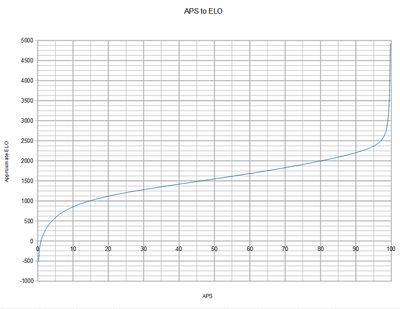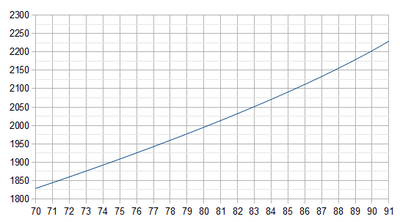Approximate ELO
I have been mulling around ways to approximate ELO for awhile. Since originally it was used for ranking (2000 club, etc), however the rankings have drifted considerably and with the advent of APS there is no real need for it. However the number is still nice, even if the methods for calculating it have problems.
So I figured we could get our nice number without a lot of number crunching with way of a simple equation. At least that was the original theory. However APS doesn't map very well to ELO, which is not at all linear, and the data set required for calculating such an equation is incomplete.
However here are my token efforts at doing just that. The dataset I used was the 2009 Glinko-2 and APS, as it was likely the most similar to the old ELO rankings. I would ahve used those, but they lacked an APS column, and the common bots between them don't exactly line up very well (plus that decimates my data set even more).
public static final double calculateElo(double x) {
double a = 169.1;
double b = 0.02369;
double c = 334.2;
return a*Math.cosh(b*x)+c*Math.log(x);
}
public static final double calculateEloFast(double x) {
double a = 0.7082e-03;
double b = -0.3340e-05;
double c = 0.3992e-02;
return 1.0/(a+b*x+c/x);
}The first is a bit more accurate. 0 is negative infinity, and 100 is around 2450 (it should be positive infinity, but I did what I could). However with a logarithm and a cosh, it is a bit heavy to be called 700+ times every a page loads (I think at least). The second is a slightly less accurate system, 0 is 0 and 100 is about 2415. With mostly simple math it is much easier to execute.
So thoughts, concerns, scorn?
For a precise ELO calculation you would need the full pairwise matrix. But for an approximation based on an APS column, it looks good.
Another way to deal with rating drift (without the full pairwise matrix) is calculating the average of all ELO ratings, then calculate the difference from the average to 1600, then add/subtract the difference to all drifted ratings. So you have ratings centered around 1600. Works with both ELO and Glicko-2 ratings columns.
Does it currently do that? The Glinko-2 has drifted up, the 2000 club now consists of only the top 16 bots.
Which is why I was considering trying to make a Approximate version. However, with mine instead of drifting down I think I see higher bots drifting up, and lower bots drifting even more down. I think this is because as new lower bots are added the APS for higher robots go up, and robots that did worse against it go down.
So it faces an entirely different kind of drift, but at least the center seems stable.
ELO/Glicko-2 work with differences between ratings.
The more competitors the ranking has, the more the rating difference between first and last places will be. This is normal.
But ELO has another drifting problem due to deflation. All competitors ratings going down because most retired competitors have ratings above the average.
static final double DRIFTED_ELO_AVERAGE = -2397.92418506835;
static final double DRIFTED_GLICKO2_AVERAGE = 1468.99474237645;
static final double DESIRED_AVERAGE = 1600;
static double calculateElo(double driftedElo) {
return driftedElo - DRIFTED_ELO_AVERAGE + DESIRED_AVERAGE;
}
static double calculateGlicko2(double driftedGlicko2) {
return driftedGlicko2 - DRIFTED_GLICKO2_AVERAGE + DESIRED_AVERAGE;
}I'd be fine with a new ELO formula to replace the currently useless one, but I can't see myself ever again caring about ELO or Glicko over straight APS for the main overall score rating. APS is clear, stable, accurate and meaningful, and ELO/Glicko just seem like attempts to solve a problem we don't have. As far as new permanent scoring methods, I'm much more interested in the Condorcet / Schulze / APW ideas brought up in the discussions on Talk:Offline batch ELO rating system, Talk:King maker, and Talk:Darkcanuck/RRServer/Ratings#Schulze_.26_Tideman_Condorcet. I also really like what Skilgannon did with ANPP in LiteRumble, where 0 is the worst score against a bot and 100 is the best score against a bot, scaling linearly.
The main advantage of ELO/Glicko-2 over other systems is they work well with incomplete pairings, and yes, we almost don´t have problems related to incomplete pairings.
But there are other smaller advantages, like higher accuracy with scores near 0% or 100% due to its S shaped (logistic distribution) function. Being able to "forget" the past also makes ELO/Glicko-2 adequate in meleerumble where historical contamination is an issue.
And I would really like to see a Ranked Pairs ranking. This would bring something new to the rumble. It is superior to the current PL (Copeland) system in almost every way, except maybe CPU/memory performance. I was thinking in building another RoboRumble server myself, designed specifically to calculate complex rankings like Ranked Pairs. But didn´t find the time to do it yet.
The thing about ranked pairs is that I haven't seen any which provide absolute scores per bot, rather than relative scores - I guess this is just part of the definition? Because of this there isn't any way to make partial improvements however, which makes it meaningless as a testing metric. Also, they are usually difficult to understand (conceptually), so understanding which pairing is causing a score loss is harder. That's why I like the Win% and Vote% as metrics for robustness, and APS for overall strength, because they are easy to understand, calculate and identify problem bots.
In Ranked Pairs, competitors causing problems are always above in the ranking, with the one causing most problems almost always directly above. Competitors below in the ranking never cause problems.
Unless you are competing for the bottom, when you reverse the logic. Competitors causing problems are always below, and competitors above never cause problems.
Although the calculation is complex, the resulting ranking follows a rather straighforward transitive logic. Winners staying above losers, with this always being true between adjacent competitors in the ranking.
This is due to 3 criteria being met at the same time, ISDA, LIIA and cloneproof.
But Ranked Pairs is not meant to replace APS or ELO, it is meant to replace PL (Copeland). APS and ELO give a rating which helps track improvement while Ranked Pairs and Copeland don´t.
I think if you add a d/(100-x) term it will improve the fit near the top. Perhaps use d*(100-x)^e for the slow/accurate version, although you can't use simple linear algebra to find the best e then, a genetic approach would probably be better.
I like the idea of this, just for historical reasons to have a decent mapping of APS to ELO, and would consider adding a column in the LiteRumble page for it. I would calculate this on the fly as the page loads, since for me with Python on App Engine the slow part of the code is the interpretation of the code, not the individual math operations the code calls =)Of course I'd have to test to make sure it doesn't slow it down too much, but it should be fine, the fast version if nothing else.
Ah good idea, how about this? It is a real mess at the moment. But it seems to work, and is a bit more accurate in my opinion in placing certain bots where they belong. It also has negative and positive infinity for 0 and 100.
public static final double calculateApproxElo(double x) {
double a = 0.0007082;
double b = -0.00000334;
double c = 0.003992;
double d = -124.3;
double e = 647.4;
double f = -72.5;
return 1.0/(a+b*x+c/x) + d/x + e/(100-x) + f;
}
That is, Diamond and DrussGT are in the 2200 (only just), Phoenix up are in the 2100, Help and up are 2000. The 1900's start around Raiko/Lacrimas.
If you want to enforce a specific rating for a specific competitor, you can also adjust the DESIRED_AVERAGE in the algorithm above so ratings match what you want.
If you change the rating difference between competitors, you distort expected score estimation, PBI and specialization indexes. It is no longer ELO-like.
That´s why the code I put above shifts all competitors up or down equally.
Looks pretty good. Any chance you could show that first graph overlayed with a scatter plot of the training samples you used?
The first one was generated (calcelofast). I used all samples from 2009 rumble archive aps and glinko-2.
From there it was hand tuned to be honest.
Wow, ok. It would only be a couple lines of Matlab/Scilab to do a proper regression though. Wouldn't that be better?
Try this: elo(APS) = -300*ln(100/APS - 1) + 1600
It uses a reflected normal sigmoid so (I think) it's based off of the same theory that the ELO is. Here's a pretty graph =) It's properly centered at 1600 as well, unlike our glicko2 implementation which it seems has drifted - 50APS doesn't line up with 1600 like it used to (perhaps due to more strong bots re-submitted like MN was saying).
Hey that's not bad! It places some of the top 20 a bit high, and that bugs me a little, but every other bot fits a bit better.
My biggest worry is it places YersiniaPestis and up in the 2100's and Tomcat is very close to the 2200 (not really a problem), and the top 2 are over halfway to the 2300s (not a problem really, since they are in their own little universe anyway).
Traditionally the 2100's started around Phoenix (85.78), but Shadow (84.69) up would be perfectly fine.

